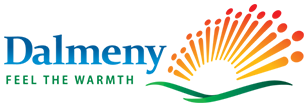Our History
In 1901 a few Russian-born, German-speaking Mennonites from Minnesota and Nebraska arrived in the "Last Best West” to put down roots on land that had once felt the thundering hoofs of buffalo herds and the transient footsteps of the people who depended upon them. Just 25 years earlier, Treaty 6 had been signed at Fort Carlton, forever changing the First Nations traditional way of life.
Railway companies scrambled to build a network of rail to serve the newcomers. The Canadian Northern advanced west through what would become Dalmeny in 1905. Two churches had already been built to the north and west by the first Mennonite homesteaders. A post office and an elevator opened in 1906. False-fronted buildings soon faced each other across a broad main street. By 1910 residents had organized a telephone company and in 1912 Dalmeny was incorporated as a village. Three-quarters of its 100 residents were Mennonites.
According to the Canadian Northern, in 1913 Dalmeny had a butcher shop, blacksmith shop, drug store, three elevators, two general stores, one hardware store, three implement warehouses, livery barn, lumberyard, restaurant and a public school. Land prices ranged from $18 to $40 per acre.
In 1914 the village was unincorporated for unknown reasons then incorporated again five years later. The 1920s saw continued growth. A new public school and a Saskatchewan Wheat Pool were added in 1928. With the support of area churches, Tabor Bible School was built the same year. In 1930 a Saskatoon power plant supplied electricity to the village and the highway from Saskatoon to North Battleford passed through Dalmeny.
The Dirty Thirties were tough on Dalmeny and other Saskatchewan communities. Crops were poor and jobs were scarce. Some men left to look for work. In 1938 Council asked the federal government for food for families on "relief.”
During the Second World War, few Dalmeny area residents signed up because the population was still largely pacifist Mennonite. Some young men chose alternate service instead of the military and were sent to work in the national parks. Soon after the War, several former air force buildings were moved from Saskatoon to Dalmeny for use by Tabor Bible School. When the Bible School closed in 1955, some of the buildings were torn down and the lumber used to build the Home for the Aged.
In the 1960s, Dalmeny began to modernize, providing natural gas, water and sewer services. But by the end of the decade, Dalmeny’s future was uncertain as people were moving away.
Reminiscing for the Dalmeny Review in 1977, Mayor Jake Loewen recalled …” one cold winter’s night at our Council meeting, we decided we were not going to let Dalmeny die without a fight. We decided we would start giving lots away rather than hang on to them and perish.”
With building lots available for $1, the village attracted new people. The population more than doubled between 1971 and the early 1980s. As the town grew, so did the need for more services, school improvements and recreational facilities.
Today Dalmeny is a thriving, attractive community with a modest business core and both elementary and high schools. The country churches have long since moved to town and built new buildings. The town office and municipal police service share a modern building with the library. Spruce Manor Special Care Home replaced the Home for the Aged. A volunteer fire department and first responders serve Dalmeny and area.
For the sports-minded, there's a modern rink with artificial ice, curling rink, soccer pitch and ball diamonds. Dalmeny Spray and Play Park opened in 2015 with new play structures and a memorial honouring Corporal Shane Keating, a Dalmeny native who died in 2006 while serving with Canadian forces in Afghanistan.
The new highway into town has made the commute to the city much more pleasant and new housing developments continue to attract people to Dalmeny.
"We are working hard to foster a sense of belonging in our community. We want to make sure that everyone feels like Dalmeny is home,” says Mayor Jon Kroeker. "We love gathering to have fun together at the hockey or curling rink, ball diamonds or parks, and especially during our annual Dalmeny Days celebration in June. "
Credit: Ruth Bitner
